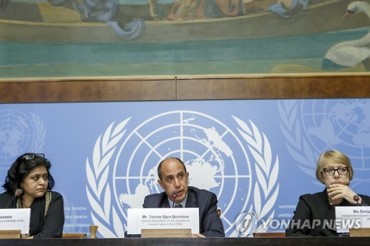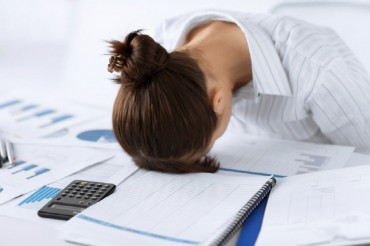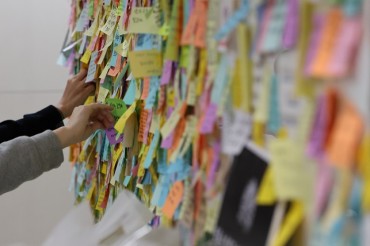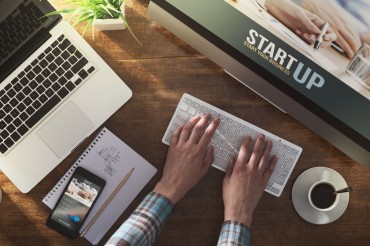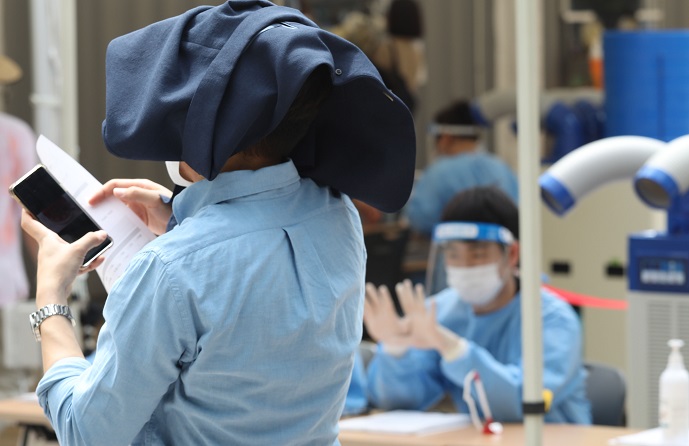
A citizen covers his head with his jacket to avoid sunlight as he waits in a line to receive COVID-19 tests in central Seoul on July 14, 2021. (Yonhap)
SEOUL, July 14 (Korea Bizwire) — South Korea’s daily virus cases hit yet another fresh high Wednesday as the country battles the fourth wave of the pandemic amid woes over rising delta variant cases and a slow vaccination process.
The country added 1,615 new COVID-19 cases, including 1,568 local infections, raising the total caseload to 171,911, according to the Korea Disease Control and Prevention Agency (KDCA).
The daily figures have stayed above 1,000 for eight consecutive days.
Concerns have grown here over a further uptick in new infections amid the fast spread of the more contagious delta variant and the summer season despite toughened virus curbs.
The greater Seoul area, home to half of the country’s 51.3 million population, has been under the toughest level of distancing since Monday.
The country added two more COVID-19 deaths, raising the death toll to 2,048. The fatality rate came to 1.19 percent.
Health authorities earlier warned that the daily virus cases may rise to the mid-2,000s in mid-August, before falling to as low as the 600s by the end of next month, should the fourth wave of the pandemic be brought under control.
“Daily cases have set a fresh high. It is likely that the number will grow down the road for the time being,” KDCA chief Jeong Eun-kyeong said during a daily briefing.
As of 9 p.m., the country reported 1,421 new cases, down by 19 from the same time the previous day. Seoul and its surrounding Gyeonggi Province had 515 and 467 cases, respectively.
As new cases in the greater Seoul area account for 80 percent of the daily caseload, the country implemented a semi-lockdown in the region that centers on banning gatherings of more than two people after 6 p.m.
Under the highest social distancing measures of Level 4, entertainment establishments, including nightclubs and bars, are ordered to shut down in the capital area, while restaurants are allowed to have dine-in customers only until 10 p.m.
Starting Thursday, most areas outside the greater Seoul area will be placed under the second-highest restrictions, in which gatherings of more than eight people are banned around the clock, according to health authorities.
The ceilings, however, vary depending on provincial governments’ policies.
Non-capital regions have been under the lowest social distancing scheme with no ceiling on gatherings.
Restaurants are allowed to operate until midnight at Level 2.
Some regions, including the central administration city of Sejong, along with North and South Jeolla provinces, will be under Level 1 distancing.
But the country’s virus battle has been put on edge due to rising variant cases and soaring untraceable infections.
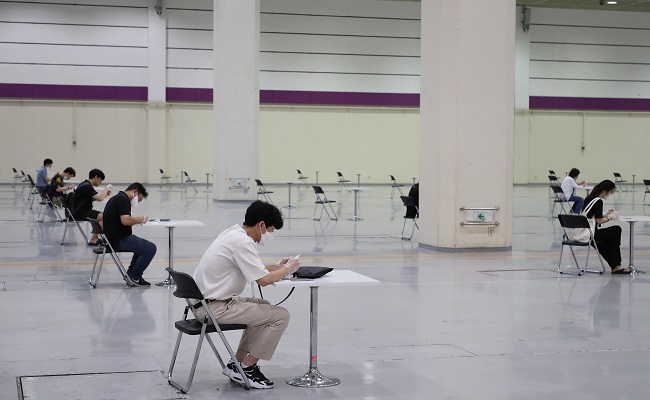
Visitors at the Coffee Expo Seoul 2021 take self-virus tests before entering the venue in southern Seoul on July 14, 2021. (Yonhap)
The more contagious delta strain of COVID-19 took up nearly 70 percent of newly identified variant cases last week.
Over the past two weeks, around 30.9 percent of the newly added patients had unknown transmission routes.
The spike in virus cases came as the country’s vaccination program has been slow since June due to a tight supply of jabs.
A total of 15.6 million people, or 30.6 percent of the country’s population, have received their first shots of COVID-19 vaccines, remaining almost unchanged from 29.8 percent tallied at end-June.
The KDCA said 6 million people have been fully vaccinated, accounting for 11.8 percent of the population.
South Korea said it has identified 103,151 cases of suspected side effects among people who have received the shots. Around 95 percent of them, however, were mild symptoms.
Health authorities said they will receive applications for inoculation for those aged from 55 to 59 later in the day.
“The amount of Moderna jabs scheduled to arrive here over the third quarter is enough to vaccinate all people in their 50s,” Jeong said.
Authorities said they are considering having people apply for jabs on designated days to avoid congestion for those aged below 50. Last year, South Korea applied a similar scheme to the purchase of facial masks amid supply shortages.
South Korea is also currently under talks with the medical community to provide COVID-19 shots at late hours for workers who cannot go to clinics during the daytime.
Of the newly confirmed domestic cases, 633 were from Seoul, 453 from the surrounding Gyeonggi Province and 93 from the western port city of Incheon.
The southeastern port city of Busan reported 62 cases, and Daegu added 52 new infections. South Gyeongsang Province found 87 new cases.
Major cluster infections included an elementary school in Incheon, 40 kilometers west of Seoul, which reported 17 cases, including nine students.
An office building from central Seoul has also added 17 infections so far.
A total of 16 cases were traced to a PC cafe from Gwangmyeong, south of Seoul.
There were 47 additional imported cases.
Indonesia accounted for eight cases, followed by Cambodia with five infections. There were also four cases among arrivals from the United States.
The total number of people released from quarantine after making full recoveries was 155,491, up 739 from a day earlier.
The number of patients in critical condition came to 163, up 17 from the previous day.
South Korea carried out 11,008,859 COVID-19 tests so far, including 44,560 from the previous day.
(Yonhap)



